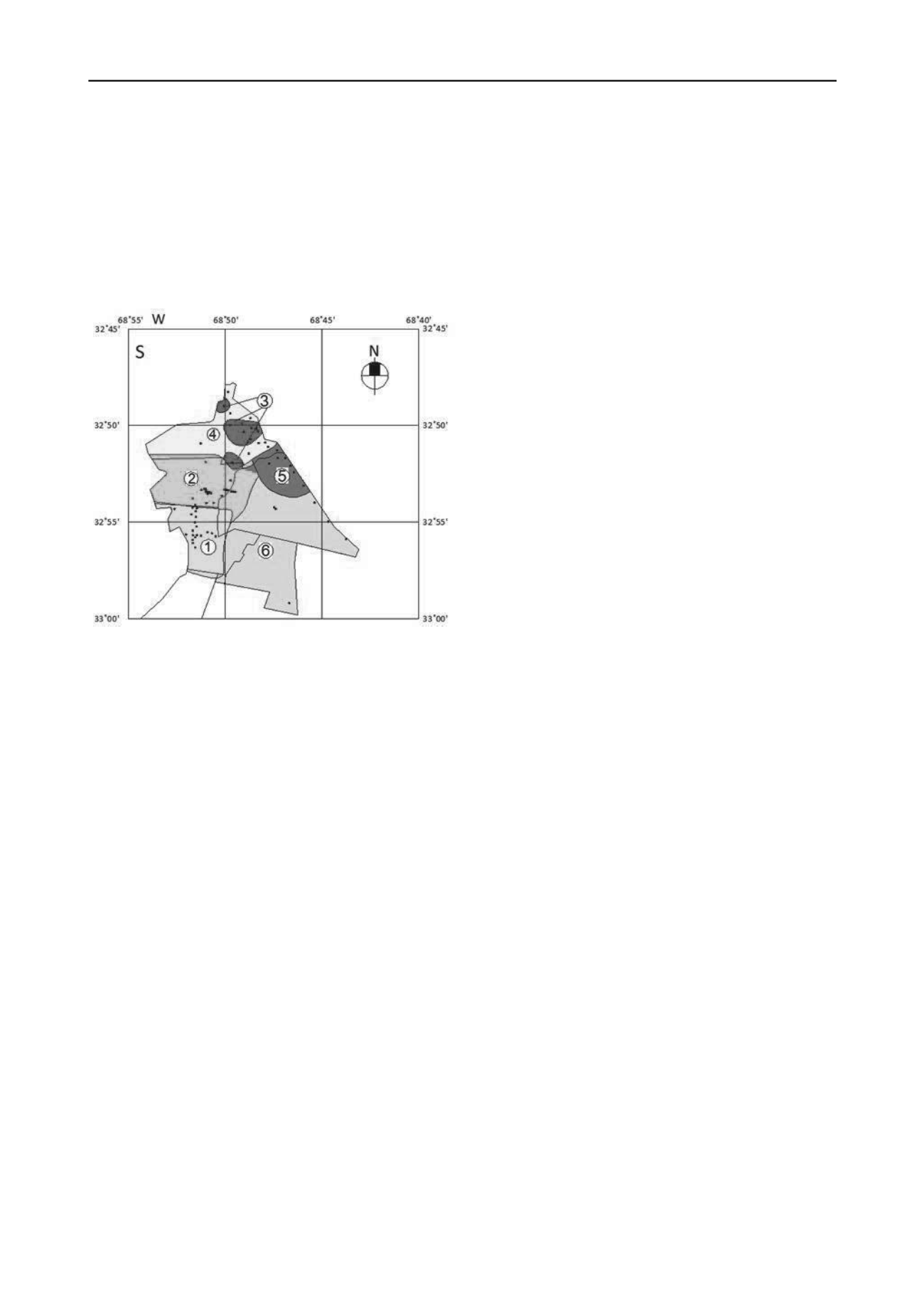
1434
Proceedings of the 18
th
International Conference on Soil Mechanics and Geotechnical Engineering, Paris 2013
Zone 4, a
máx
= (1.80 ÷ 2.20g) and T = (0.34 ÷ 0.45s),
corresponds to an alluvial plain sector with fine deposits (silts)
10 to 14m in thick that lie upon high shear wave velocities
gravels.
6
ACKNOWLEDGEMENTS
Figure 6 shows spectra corresponding to Zone 6, a
máx
= (1.15
÷ 1.40g) and T = (0.09 ÷ 0.20s) with coarse deposits for the
alluvial cone that eventually outcrop.
Zone 5, a
máx
= (2.20 ÷ 2.80g) and T = (0.18 ÷ 0.35s),
corresponds to an alluvial plain sector with presence of sandy
and eventually silty deposits 5 to 7m in thick that lie upon high
shear wave velocities gravels.
The Authors are very grateful to the National Institute for
Seismic Prevention from Argentina (INPRES) by the
information provided and to the Secretary of Science
Technology and Postgraduate Studies from the Cuyo National
University in Mendoza, Argentina for facilitate and promote
this research project and the publishing of this paper.
7
REFERENCES
Barchiesi A.M. 2009. Efectos de Sitio Sísmicos en el Área Urbana del
Gran Mendoza: Intensificación de los Estudios.
Informe Final
Proyectos Bienales 2007 - 2009, Universidad Nacional de Cuyo
.
Barchiesi A.M., Fernández F., Placci M. 2010. Construcción de una
Columna Resonante y Primeras Mediciones.
XX Congreso
Argentino de Mecánica de Suelos e Ingeniería Geotécnica (XX
CAMSIG 2010), Mendoza, Argentina, 6 al 9 de octubre 2010
.
Barchiesi A.M., Schnetzer T.F., Howe C.E. 2010. Efectos de Sitio
Sísmicos en Mendoza: Estimaciones Iniciales.
XX Congreso
Argentino de Mecánica de Suelos e Ingeniería Geotécnica (XX
CAMSIG 2010), Mendoza, Argentina, 6 al 9 de octubre 2010
.
Barchiesi A.M. – Mancipe C.A. 2012. Efectos de sitio sísmicos en la
ciudad de Mendoza y alrededores: avances en la determinación de
las propiedades dinámicas de los suelos.
XI Congreso Argentino de
Mecánica de Suelos e Ingeniería Geotécnica (XI CAMSIG 2012).
Rosario, Argentina, 11al 14 de Septiembre 2012
.
Barchiesi A.M. 2010. La Planificación Urbana en Relación con la
Problemática Sísmica.
Revista “La Ingeniería”, Nº1103 del Centro
Argentino de Ingenieros (CAI) en edición especial por el
“Congreso Mundial y Exposición INGENIERIA 2010 –
ARGENTINA: Tecnología, Innovación y Producción para el
Desarrollo Sostenible”, Buenos Aires, octubre 2010
.
Bardet J.P., Ichii K., Lin C.H. 2000. EERA.
Departament of Civil
Engineering, University of Southern California
.
Figure 7: Proposed seismic zoning map
Bardet J. P., Tobita T. 2001. NERA.
Departament of Civil Engineering,
University of Southern California
.
5
CONCLUSIONS
Numeric modeling made evident six zones characterized by its
acceleration levels and amplifying periods. These zones run
from rigid deposits into the alluvial cone with smaller maximum
accelerations values and reduced amplifying periods to fine
deep deposits into the alluvial plain with medium maximum
accelerations values and high amplifying periods.
Gasparini D. & Vanmarcke E., January 1976. SIMQKE A Program for
Artificial Motion Generation.
Massachussets Institute of
Technology, Departament of Civil Engineering.
Instituto Nacional de Prevención Sísmica de la República Argentina
INPRES.
INPRES 1991. Reglamento INPRES CIRSOC 103 Normas Argentinas
para Construcción Sismorresistente – Parte I Construcciones en
General.
The highest accelerations correspond to the fine sediments
sector into the alluvial cone that can be associated to high
impedance due to high shear velocity (or rigidity) contrasts
made evident by the geotechnical profiles.
Lanzo G. & Silvestri F. 1999. Risposta Sismica Locale ISBN 88-86977-
13-1
Hevelius Edizioni srl, Benevento, Italia
.
Sensitivity analysis evidenced that, if an increment in
rigidity (shear wave velocity) respect to the assumed values in
profiles with predominance of coarse soils is proposed, then the
spectral amplification diminishes and in extreme practically
maintain the original spectral form in rock and inversely, if
lower rigidities than the assumed ones are proposed.
Mingorance F. 2006. Morfometría de la Escarpa de Falla Histórica
Identificada al Norte del Cerro La Cal, Zona de Falla La Cal,
Mendoza.
Revista de la Asociación Geológica Argentina 61 (4):
620.638
.
Poder Ejecutivo Nacional (Ministerio de Obras y Servicios Públicos)
1989. Microzonificación Sísmica del Gran Mendoza, Mendoza.
Schnabel, Lysmer and Seed, modifications by I. M. Idriss, Joshep I Sun
1992. SHAKE91.
Departament of Civil and Environmental
Engineering, University of California
.
For fine soils profiles in the presence of increments in
rigidity (shear wave velocity) respect to the adopted values,
spectra move to high frequencies without increments in
acceleration amplifications. In the presence of rigidity
decrements the inverse phenomenon was verified as well as a
strong reduction in acceleration amplifications that are
associated to greater deformations and damping.
Youssef M. A. Hashash 2011a. DEEP SOIL V. 4.0, Gallery, Input
Motions.
Departament of Civil and Environmental Engineering,
University of Illinois
.
Youssef M. A. Hashash 2011b. DEEP SOIL V. 4.0.
Departament of
Civil and Environmental Engineering, University of Illinois
.
For certain, the most relevant conclusion for the study has
consisted in verifying the presence of very strong seismic site
effects as well as into the necessity to intensify the studies with
the aim to arrive to a proposal for an actualized and well
founded seismic micro-zoning for Mendoza city and its
surroundings.


